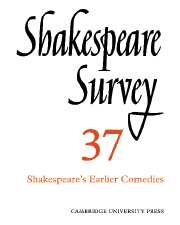Book contents
- Frontmatter
- Criticism of the Comedies up to The Merchant of Venice: 1953–82
- Plotting the Early Comedies: The Comedy of Errors, Love’s Labour’s Lost, The Two Gentlemen of Verona
- The Good Marriage of Katherine and Petruchio
- Shrewd and Kindly Farce
- Illustrations to A Midsummer Night’s Dream before 1920
- The Nature of Portia’s Victory: Turning to Men in The Merchant of Venice
- Nature’s Originals: Value in Shakespearian Pastoral
- 'Contrarieties agree': An Aspect of Dramatic Technique in Henry VI
- Falstaff’s Broken Voice
- ‘He who the sword of heaven will bear’: The Duke versus Angelo in Measure for Measure
- War and Sex in All’s Well That Ends Well
- Changing Places in Othello
- Prospero’s Lime Tree and the Pursuit of Vanitas
- Shakespearian Character Study to 1800
- How German is Shakespeare in Germany? Recent Trends in Criticism and Performance in West Germany
- Shakespeare Performances in Stratford upon–Avon–and London, 1982–3
- The Year's Contributions to Shakespearian Study 1 Critical Studies
- 2 Shakespeare’s Life, Times and Stage
- 3 Editions and Textual Studies
- Index
Illustrations to A Midsummer Night’s Dream before 1920
Published online by Cambridge University Press: 28 March 2007
- Frontmatter
- Criticism of the Comedies up to The Merchant of Venice: 1953–82
- Plotting the Early Comedies: The Comedy of Errors, Love’s Labour’s Lost, The Two Gentlemen of Verona
- The Good Marriage of Katherine and Petruchio
- Shrewd and Kindly Farce
- Illustrations to A Midsummer Night’s Dream before 1920
- The Nature of Portia’s Victory: Turning to Men in The Merchant of Venice
- Nature’s Originals: Value in Shakespearian Pastoral
- 'Contrarieties agree': An Aspect of Dramatic Technique in Henry VI
- Falstaff’s Broken Voice
- ‘He who the sword of heaven will bear’: The Duke versus Angelo in Measure for Measure
- War and Sex in All’s Well That Ends Well
- Changing Places in Othello
- Prospero’s Lime Tree and the Pursuit of Vanitas
- Shakespearian Character Study to 1800
- How German is Shakespeare in Germany? Recent Trends in Criticism and Performance in West Germany
- Shakespeare Performances in Stratford upon–Avon–and London, 1982–3
- The Year's Contributions to Shakespearian Study 1 Critical Studies
- 2 Shakespeare’s Life, Times and Stage
- 3 Editions and Textual Studies
- Index
Summary
It is somewhat – if not wholly – presumptuous to present a piece on the subject of illustrations to one play of Shakespeare when the groundwork for the study of illustrations to the whole of Shakespeare has already been so carefully achieved by W. Moelwyn Merchant in his book Shakespeare and the Artist, published by the Oxford University Press in 1959, and by T. S. R. Boase in his Illustrations of Shakespeare’s Plays in the Seventeenth and Eighteenth Centuries, a detailed contribution to the Journal of the Warburg and Courtauld Institutes in 1947. This short article could not have been prepared without them. I shall confine myself to illustration in the strict interpretation of the word, that is to a selection – by no means comprehensive – of illustrations in published texts and to drawings and paintings which represent episodes from the play. I shall not discuss representations of actual stage productions or designs for sets or costumes. In the case of A Midsummer Night’s Dream, which did not become a widely popular subject until well into the nineteenth century, and which at all times has been better known for its ‘fairy’ content than its court-and-love intrigue, the illustrations range from the ethos of the baroque masque through the academic restriction of the late eighteenth century to the kind of historical and un-Shakespearian approach of the mid and late nineteenth century which is implied in the word ‘revival’.
- Type
- Chapter
- Information
- Shakespeare Survey , pp. 41 - 54Publisher: Cambridge University PressPrint publication year: 1984
- 1
- Cited by

